©
2004 Jeff Matthews & napoli.com
Gaiola
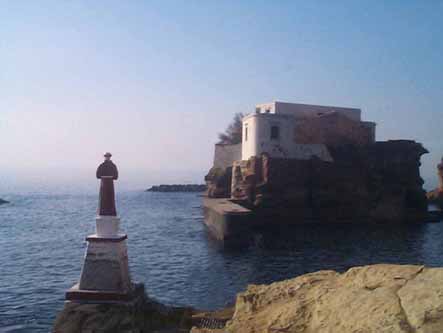 This tiny isle,
Gaiola, is but a few yards from shore, just east of Cape Posillipo. It
is the site of an ancient navigators' shrine to Venus as well as near
the site of the few Roman ruins of "the sorcerer's house"
where the poet Virgil, also renowned as
a magician, is said to have taught. In this picture, it is watched by
a small statue of St. Francis. This tiny isle,
Gaiola, is but a few yards from shore, just east of Cape Posillipo. It
is the site of an ancient navigators' shrine to Venus as well as near
the site of the few Roman ruins of "the sorcerer's house"
where the poet Virgil, also renowned as
a magician, is said to have taught. In this picture, it is watched by
a small statue of St. Francis.
Gaiola
has two small neighbor islets. The modern house on it is abandoned and,
at last notice, the isle and house were up for sale—with no takers!
Over the centuries, Gaiola has developed a reputation of being haunted
and there are many rumors about the misfortunes —including violent
death— that befall those who inhabit it. These rumors, obviously,
were not started by real estate agents.
Greek
Orthodox Church
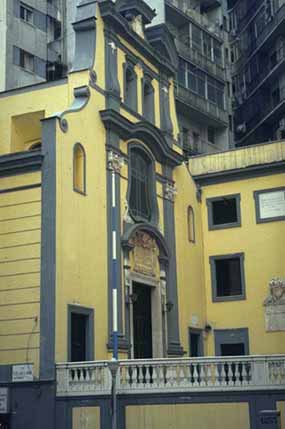 In 330 a.d. a Christian
convert built a Christian city to replace the old and pagan Rome. His
—Constantine the Great's— faith would soon be proclaimed
the official religion of the Roman Empire. The bad news would be that
he had inadvertently made it possible for that Empire to be divided
in two, sundering its church right along with it. In 330 a.d. a Christian
convert built a Christian city to replace the old and pagan Rome. His
—Constantine the Great's— faith would soon be proclaimed
the official religion of the Roman Empire. The bad news would be that
he had inadvertently made it possible for that Empire to be divided
in two, sundering its church right along with it.
There were
organizational problems among early Christians. Should the bishops of
Rome, Alexandria, Ephesus, Antioch and Constantinople all have equal
authority? Or should Rome dominate, based on its imperial political
status and the special history of the Roman church —that is, its
founding by the apostle Peter? This squabble was joined by divisive
theological ones: debates on the nature of God, Christ and the
Trinity.
When the
Western Roman Empire fell in 476, the Western church bided its time
with organizational matters. The lack of imperial authority actually
led to a strengthening of the Roman church, since it took over a number
of civic functions it might never have had to, if there had remained
in place a true imperial bureaucracy in the West.
On the
other hand, Constantinople viewed itself as the natural continuation
of Empire. The emperor was "High Priest and King," God's emissary on
earth and the head of the Church. He could not owe allegiance to anyone
else, much less a bishop of the Western church. In the years between
500 and 800, Constantinople became by default a Greek State: the
Byzantine Empire. Latin ceased to be the official language of government
and was replaced by Greek, accentuating the religious differences and
accelerating the separation of the Greek and Roman Churches.
The reestablishment
of a Western Empire by Charlemagne in 800 meant that there were two
strong competing Christian empires. In the two centuries that followed,
while having to relinquish Asia Minor and the Middle East to the surge
of Islam, the East remained powerful, spreading to carry Orthodox (meaning
"Right Faith") Christianity to Russia. The Western Empire carried its
faith to the north and to the British Isles. In spite of seven ecumenical
conferences held over the centuries to resolve theological differences,
the two churches finally excommunicated each other in 1054. This was
called the great Schism and effectively destroyed the integrity of the
Christian Church.
At present
the Orthodox Eastern Church has approximately 150 million followers,
and is the second largest Christian denomination in the world. It is
composed of 15 self-governing churches worldwide, such as, among others,
the Russian Orthodox Church, the Cyprus Orthodox Church and the Greek
Orthodox Church.
Greeks
and Naples have always had a special relationship. First, of course,
the city was founded by the Greeks. But even later, when Naples and
Greece, itself, were part of the Roman Empire, Greek remained a widely
spoken language in Naples. When the West fell to the Goths, Naples fell
with it, but was quickly retaken by the Byzantine Empire. Byzantine
power surged and ebbed in Southern Italy in the sixth, seventh and eighth
centuries, but Greek influence in Naples remained strong. Even after
Charlemagne refounded the Western Empire, southern Italy was not part
of it. In spite of the growing hostility between the Eastern and Western
branches of Christianity, there were Eastern Churches and monasteries
all over the south, Naples included. After the Schism, Orthodox rites
were still commonly held in and around Naples, and there was even a
Greek monastery in use here until the Counter-Reformation in the 17th
century. Visitors to the Naples Cathedral will still find a double baptistery
inside, one for Roman Catholic rites and the other for Greek rites.
Also, for reasons obscured by time, a benediction by a Greek Orthodox
priest is considered particularly auspicious by otherwise quite Roman
Catholic Neapolitans. It is, according to popular custom, one of the
ways in which the so-called malocchio, the 'evil eye,' can be
warded off.
The Greek
Orthodox Church in Naples is on Via S. Tommaso Aquino in the downtown
area. It was founded as the "Confraternity of Greeks Resident
in the City of Naples" almost immediately after the fall of Constantinople
in the 15th century by Greek refugees from that event.
In 1518,
a Byzantine prince, Tommaso Assanios Paleologos, paid for the construction
of the chapel. The text of the Greek rites were defined in 1760 by a
decree of the Bourbon Kingdom of Two Sicilies.
The status of the church, as defined by the Bourbons, was accepted by
the new Italian State after the unification of Italy in the 19th century.
The members
of the confraternity vote by secret ballot on how to distribute income
from offerings and the few properties that the Church owns in Naples.
Monies are used for philanthropic and educational purposes, as well
as to pay those who work for the church. Such income has helped to create
an elementary school for Greek children as well as children of mixed
marriages. There is also an auditorium for social gatherings.
The church,
itself, is small and intensely spiritual. The silver icons have an overpowering
presence and are close enough to touch —indeed, they are meant
to be touched. Personally, I first noticed the music. Byzantine chants
are related at some point in a higher dimension to their Gregorian cousins
in the Western church, but a thousand words detailing untempered minor
scales, mysterious quarter-tones and the Eastern passion for the ornamental
quiver in the voice would do as little justice to the music of Byzantium
as my other words have done to the religion. You will have to go hear
and see for yourselves.
Plebiscito,
Piazza; Naples Prefecture; San Francesco di Paola
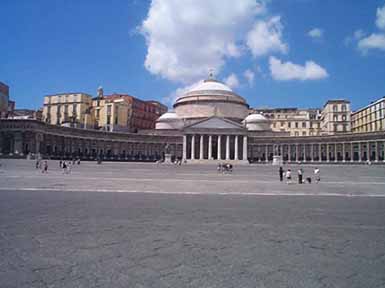 Piazza Plebiscito
is the largest square in Naples. It is bounded on the east by the Royal
Palace and on the west by the church of San Francesco di Paola (photo,
left) with its impressive colonnades extending to both sides.
In the first years of the 19th century, the King of Naples was Gioacchino
Murat (Napoleon's brother-in-law). He started to build, as a bit
of imperial splendour, a Romanesque forum in the square. When Napoleon
was finally dispatched, the Bourbons were restored to the throne of
Naples. Ferdinand I continued the construction but was so grateful at
having his kingdom back that he made the finished product into
church you see today. He dedicated it to San Francesco di Paola, who
had stayed in a monastary on this site in the 16th century. The
church is reminiscent of the Pantheon in Rome. The façade
is fronted by a portico resting on six columns and two Ionic pillars.
Inside, the church is circular with two side chapels. The dome is 53
metres high. Piazza Plebiscito
is the largest square in Naples. It is bounded on the east by the Royal
Palace and on the west by the church of San Francesco di Paola (photo,
left) with its impressive colonnades extending to both sides.
In the first years of the 19th century, the King of Naples was Gioacchino
Murat (Napoleon's brother-in-law). He started to build, as a bit
of imperial splendour, a Romanesque forum in the square. When Napoleon
was finally dispatched, the Bourbons were restored to the throne of
Naples. Ferdinand I continued the construction but was so grateful at
having his kingdom back that he made the finished product into
church you see today. He dedicated it to San Francesco di Paola, who
had stayed in a monastary on this site in the 16th century. The
church is reminiscent of the Pantheon in Rome. The façade
is fronted by a portico resting on six columns and two Ionic pillars.
Inside, the church is circular with two side chapels. The dome is 53
metres high.
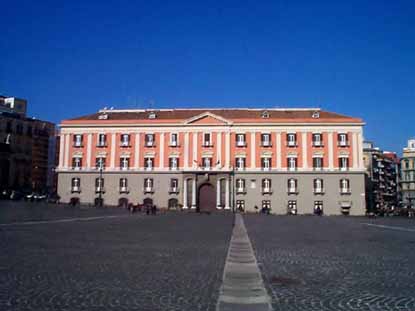 On the north side
of the square is the Naples Prefecture (photo, right). It is on the
site of the old Convent of the Holy Spirit built in the early 1300s.
The clearing away of the monastery was part of the general campaign
by the French during the Napoleonic decade under Murat in Naples (1806-1815)
to, one, supress monastic orders and, two, rebuild the space in front
of the Royal Palace. This building was started in 1810, suspended when
the Bourbons returned to the throne of Naples in 1815, and then continued,
following the original plans. It is a "twin" of Palazzo Salerno,
the building facing it from directly across the square. That building
houses the Regional Military Command and, in spite of the identical
appearance, is older; it was built in 1775 by the Bourbons to house
a batallion of military cadets. Palazzo Salerno, however, was
then redone to look like the newer one in the photo as part of
the French and then Bourbon plan to rebuild the square. Actually, the
Prefecture is better known to most because it is adjacent to the Gambrinus
cafe, a favorite haunt of poets and musicians during the late 1800s
and early 1900s and, today, a favorite tourist attraction. On the north side
of the square is the Naples Prefecture (photo, right). It is on the
site of the old Convent of the Holy Spirit built in the early 1300s.
The clearing away of the monastery was part of the general campaign
by the French during the Napoleonic decade under Murat in Naples (1806-1815)
to, one, supress monastic orders and, two, rebuild the space in front
of the Royal Palace. This building was started in 1810, suspended when
the Bourbons returned to the throne of Naples in 1815, and then continued,
following the original plans. It is a "twin" of Palazzo Salerno,
the building facing it from directly across the square. That building
houses the Regional Military Command and, in spite of the identical
appearance, is older; it was built in 1775 by the Bourbons to house
a batallion of military cadets. Palazzo Salerno, however, was
then redone to look like the newer one in the photo as part of
the French and then Bourbon plan to rebuild the square. Actually, the
Prefecture is better known to most because it is adjacent to the Gambrinus
cafe, a favorite haunt of poets and musicians during the late 1800s
and early 1900s and, today, a favorite tourist attraction.
Until
quite recently, the square had been allowed to fall victim to an urban
decay of sorts; i.e. it had turned into one gigantic parking lot. As
part of the general plan to make the city more enjoyable for residents
and visitors alike, Piazza Plebiscito was cleared and restored by the
city government in the early 1990s. It is now one of the big tourist
attractions in the city, a good place to stroll and get your bearings.
The square hosts various celebrations during the year, from rock concerts
to annual New Year's Eve festivities. It is also the site of periodic
displays of "installation art". The name
of the square honors the 1860 plebiscite that ratified the unification
of Italy.
Mortella,
la (1); William Walton
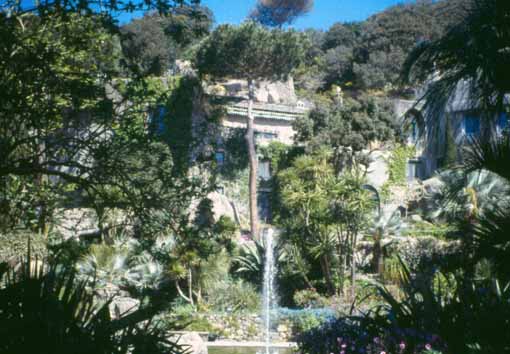 Set foot in La Mortella, the gardens of the late
English composer, William Walton, located on the island of Ischia in
the Bay of Naples, and you will know what Francis Bacon meant
when he said: "God Almighty first planted a garden. And, indeed, it
is the purest of human pleasures." Set foot in La Mortella, the gardens of the late
English composer, William Walton, located on the island of Ischia in
the Bay of Naples, and you will know what Francis Bacon meant
when he said: "God Almighty first planted a garden. And, indeed, it
is the purest of human pleasures."
The composer
and his wife, Susana, settled on Ischia in the early 1950s. There, one
of the great musical spirits of our age set about to continue his life's
work. His wife set about her own life's work, as she says, of building
"a garden for an artist." It was to be a place of serenity, something
to offset the turmoil within the composer, a place that would invite
him to look not just out at the garden, but within himself. That is
a tall order, indeed, when you start with a rocky, waterless gully covered
with a bit of evergreen holm oak and some dying chestnut trees.
The transformation
from scrubby rock quarry to enchanting blend of rock garden and tropical
rain forest was planned by the distinguished landscape architect, Russell
Page, and begun in 1956. His designs evolved through 1983, but the work
is still going on under the "green fingers" of Lady Walton, for whom
"…gardens reflect our dreams and aspirations… they are our
fantasies." In that spirit, over the years, La Mortella, has
been magically transformed — but, delightfully, not tamed. You
will not find the obedient and trimmed vegetation of, say, a Japanese
garden. La Mortella looks more like a forest ruled over by a
totally benevolent but mischievous goddess who simply can't be bothered
to pick up after herself!
Of course,
the art of true helter-skelter is to plan it carefully. Thus, the paths
curve at all the right places, and the terraces offer evershifting perspectives;
when viewed from where Walton, himself, must have paused from his work
to look out, fountains are arched by trees, and this puzzle of vegetation
suddenly solves itself and fits together.
At La
Mortella you find everything from the extravagant pot-bellied Chorisia
speciosa tree from Argentina (where they, appropriately, call it
"the drunkard") to purple-pink geraniums from Madeira; ferns from the
Canary islands and dwarf rosemary from the gardens of the University
of Jerusalem; honey-suckles from South Africa, the soft green-yellow
petals of California tulip trees, water lilies, jasmine, orchids, bright
green Thalia and —as you ascend—even the lotus, set off
meditatively alone in its own pond at the highest point of La Mortella.
Water has been brought in, not just to nourish the gardens, but to provide
for the Alhambra-like presence of fountains and pools, the sounds of
which remind us that even here in the presence of the composed music
of man, nature has its own music.
All that,
however, is just half the story. La Mortella exists as part of
the William Walton Foundation, dedicated in 1989 as a centre of the
performing arts, a place for young composers and artists to study and
perform, with "special reference" to the music of William Walton. (The
composer passed away in 1983.) Here you will find not only the Waltons'
home, but rehearsal rooms, as well. Each year, auditions are held to
select participants in a master class, a month-long session of rehearsals
culminating in performances open to the public.
At La
Mortella there is also a museum, where you can browse among
memorabilia from Walton's life as a composer, as well as watch a film
on his life and work. And there is a tea-shop, where you can sit and
simply look out over the gardens—and if that is all you do, it's
still reason enough to go.
Spanish
Quarter
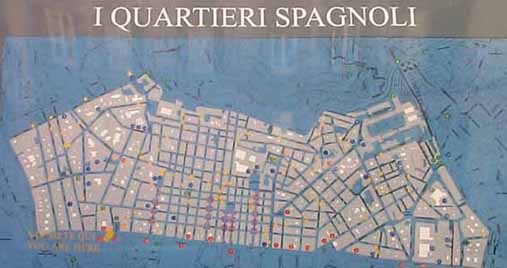
The main
shopping thoroughfare in modern Naples is via Roma, a
name thatmany Neapolitans reject in favor of the original name, via
Toledo, named for Don Pedro di Toledo, the Spanish viceroy of Naples
from 1532 to 1553. He was one of the most notable in a long line of
representatives of the Spanish throne who ruled Naples
between 1500 and 1700. Don Pedro is the viceroy who began the great
Spanish reshaping of Naples, changes that extended into every aspect
of life in the city, from the building of new living quarters to the
enlarging of port facilities and shoring up of city fortifications.
The Spanish renovation of Naples was precisely that—a renewal,
one that cast Medieval and Renaissance Naples in a modern sixteenth-century
mold, which would then carry the city directly into the age of the Baroque.
Via Toledo
begun in the late 1530s, was the centerpiece of one of the most
impressive projects undertaken by Don Pedro: the construction of an
entirely new popular quarter of the city, today called, simply,
The Spanish Quarter—or, by many Neapolitans, the Casbah(!),
thus recalling the Moorish influence in the history of the builders.
The main street, via Toledo (bounding the Spanish Quarter at the bottom
of the above map) was laid out to lead north from what is now the
square in front of the Royal Palace.
In the 1530s there was not yet a Royal Palace, but the square itself
was adjacent to the large complex that included the Maschio
Angioino and the living quarters of the Viceroy; thus, it was a
logical place to start a new main road. Via Toledo ran along the line
of an earlier city wall and was actually intended to supplant that fortification,
literally breaking the confines of the medieval city and extending it
up the slope of the hill of San Martino,
a natural barrier. Via Toledo then continued on to Largo Mercatello,
later, under the Bourbons, to be known as Foro Carolina, and
today as Piazza Dante.
The Spanish
Quarter thus starts at the beginning of via Toledo and consists
of dozens of symmetrical square blocks, with the east-west streets
running up the slope of San Martino. There are about a dozen of these
streets between the Palace and the section of Naples called Montesanto.
They lead up the slope from via Toledo and are then crossed by
a number of secondary parallel streets, each one at a progressively
higher level on the slope. The effect is of a chessboard of perfect
little squares built on the side of a hill. A great number of stairways
are built into the east-west streets to help the pedestrian climb the
slope.
The Spanish
built a number of villas and residences on the spacious sites fronting
the new via Toledo. Many of these buildings are still standing and recognizable
even through centuries of overlaid architecture. The Spanish expansion
also included the area on the other side of via Toledo and running
north towards Piazza Dante. Thus, one finds the Church of
San Giacomo degli Spagnoli on the east side of via Toledo on
what is now Piazza Municipio. The entire
area of the Spanish Quarter in the first few years of its existence
was, indeed, a "Spanish Quarter," for it was in these houses that many
of the 6,000 Spanish soldiers quartered in Naples in the mid-sixteenth
century found accommodations before moving into a central barracks in
the 1650s.
The area
behind the main street still contains some Baroque churches from the
late 1500s and early 1600s. The most famous of these is the Church of
Santa Maria della Concezione a Montecalvario, from the year 1589.
This church was also the site of an orphanage sponsored by the congregation
and which was in operation until the end of the 1800s. The church was
rebuilt in the 1720s and has a central space with side chapels and a
dome.
The residences
in the Spanish Quarter are four and five stories high, quite an accomplishment
for 1600. (Even as late as the 1870s, Mark Twain commented on the “tall
buildings of Naples”.) The blocks were an enormous departure from
the winding clutter of medieval cities and are, perhaps, the first example
of modern urban planning in Europe. "Urban planning" should, realistically,
not be understood here in the benevolent twentieth-century sense of
providing the poor with a decent place to live, however. [For a separate
item on urban planning in Naples at the beginning of the 20th century,
click here.] An age of absolute monarchy
was concerned less with such things than it was with its own physical
security.
Here, one
does well to recall Lewis Mumford’s remark that the clearing
away of the small winding medieval streets of Paris by Napoleon III
in the mid-nineteenth century did away with the last physical
barrier which protected the common citizen from the power of the absolute
state. Such was the case in Naples: a long rebellious nest of medieval
clutter into which the King’s soldiers ventured at considerable
risk was made somewhat more manageable by the introduction of broad
straight roads that were easy to patrol. The centuries have by-passed
that concept somewhat, for it is now the Spanish Quarter, itself, that
has acquired a foreboding reputation as a section of Naples where a
stranger does not enter without some concern.
[See
her for another item on Spanish buildings in Naples.]
Noodles
 I don't know that
this is the world's greatest pasta shop, but I like it. Pasta comes
as spaghetti, macaroni, fettuccini, tagliatelle,
penne, rigate, vermicelli, capellini, anelli,
spirali, fusilli, maltagliatti, et noodle cetera
—and those are just some of the common, generic Italian noodles
in the present tense. Neapolitan conjugations include—but are
not limited to (as pasta-loving legal fleagles like to say) —ziti
and paccheri.) They come in red, green, white, and even the off-brown
of (ugh!) whole-wheat health-food pasta. Also, they are stubby, skinny,
straight, wavy, cork-screwy, and shaped like a torus, also known as
an "anchor ring" (or "donut" to non-mathematicians). Attempts to create
a stable double-torus noodle have thus far been unsuccessful. (See Dente,
Al. "Getting a Handle on a Trivial Tubular Neighborhood" in the Journal
of Pasta and Topology.) I think this shop has all of them. I don't know that
this is the world's greatest pasta shop, but I like it. Pasta comes
as spaghetti, macaroni, fettuccini, tagliatelle,
penne, rigate, vermicelli, capellini, anelli,
spirali, fusilli, maltagliatti, et noodle cetera
—and those are just some of the common, generic Italian noodles
in the present tense. Neapolitan conjugations include—but are
not limited to (as pasta-loving legal fleagles like to say) —ziti
and paccheri.) They come in red, green, white, and even the off-brown
of (ugh!) whole-wheat health-food pasta. Also, they are stubby, skinny,
straight, wavy, cork-screwy, and shaped like a torus, also known as
an "anchor ring" (or "donut" to non-mathematicians). Attempts to create
a stable double-torus noodle have thus far been unsuccessful. (See Dente,
Al. "Getting a Handle on a Trivial Tubular Neighborhood" in the Journal
of Pasta and Topology.) I think this shop has all of them.
If all
that is just "noodles" to you, then maybe you don't deserve this information.
But if you are familar with the bizarre very-pre-surrealist works of
Giuseppe Arcimboldi (1527 -1593), who specialized in painting human
figures out of edibles, you will be pleased to know that his spirit
is alive and well in Naples. Mr. Noodle Head (photo) and other similar
renditions of the human head are to be found in a fascinating pasta
shop on via Benedetto Croce, a few yards after entering the old
city from the direction of Santa Chiara (approximately,where #6 is on
the map of the historic center.)
Christianity,
early; San Pietro ad Aram
Paleo—Greek
for "ancient"— means different things in different contexts.
When used in the term "paleo-Christian" in this part of Italy, it generally
refers to Christian relics and sites dating back to well before the
year 1000. Naples has a number of these to offer, though, as is the
case with many ancient things, they have been covered over by the handiwork
of later centuries.
To begin
with, the catacombs of San
Gennaro, on the way up to Capodimonte, are the most extensive and
interesting examples of early Christian cemeteries to be found in Italy
south of Rome. Also, a number of churches in Naples that now seem 'merely'
medieval have their origins in the middle of the first millennium well
before the beginning of the great age of church building. For example,
the church and vast monastic complex known as San
Gregorio Armeno located on the street of the same name goes back
to the eighth century when refugees from the iconoclast controversies
shaking Byzantine Christendom in the east fled to Italy, in this case
bringing with them to Naples the remains of their patron, Gregory of
Armenia.
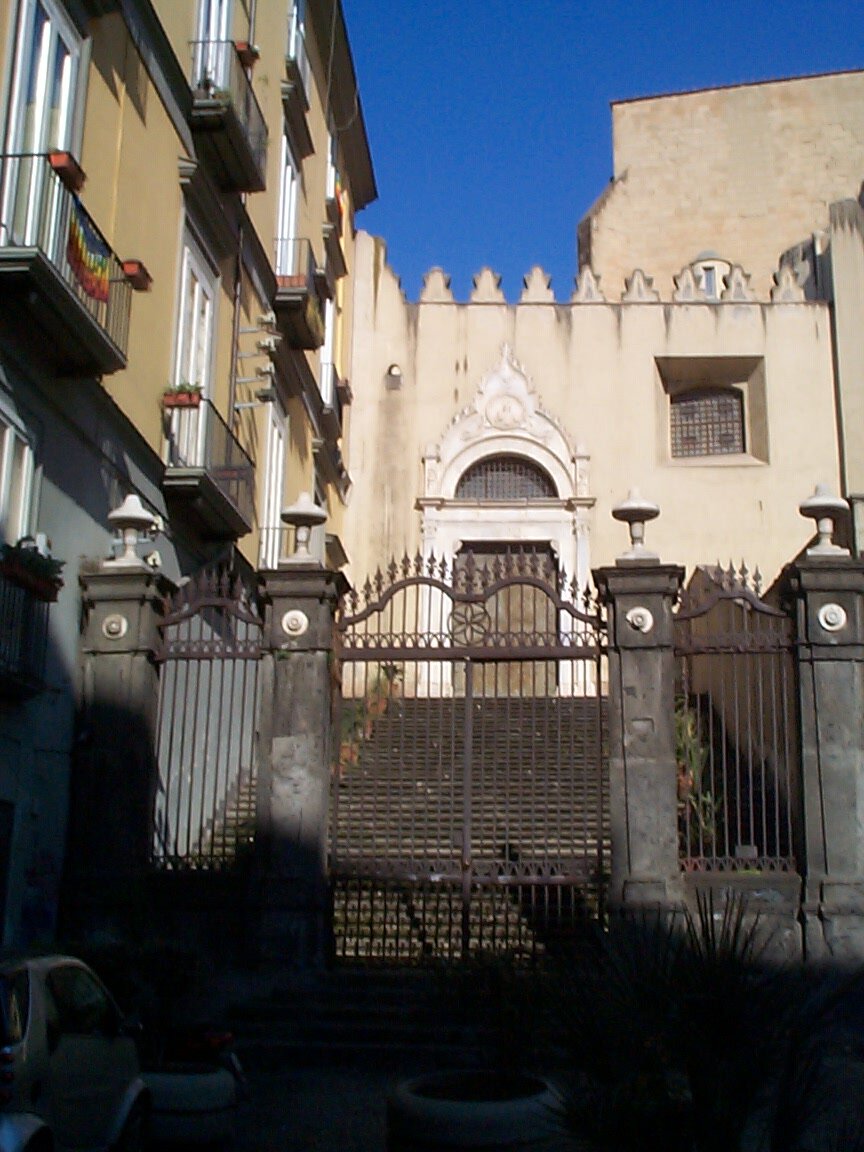
(The photo, left, shows the entrance to San
Michele Arcangelo a Morfisa, a small Byzantine
church that housed the Basilian monastic order. It is now incorporated
into the massive church of San Domenico
Maggiore, but was built centuries earlier.)
Another relic of early Christianity is hidden within the Church of San
Paolo Maggiore on via dei Tribunali, one of the three original east-west
thoroughfares of the Greek city of Neapolis. The modern church stands
above a spectacular stairway, and, in the form you see today, was built
at the end of the sixteenth century. However, it was erected on the
ruins of a preexisting eighth-century church built to celebrate a Neapolitan
sea victory over Saracen invaders. That church, by the way, was built
on the site of --and even incorporated part of the structure of—a
Greek temple dedicated to Castor and Pollux. Also, the Church of Santa
Maria Donnaregina on vico Donnaregina is on the site of an ancient
monastic complex dating back to the eighth century.
The best-known
example of a paleo-Christian church in Naples, of course, is
in the Duomo, the cathedral of Naples,
itself. Incorporated in the cathedral is the Santa Restituta basilica,
which used to be a church in its own right, built in the 6th century.
Its present three aisles divided by 27 antique columns are what is left
of the original church after the main body of the massive cathedral
was built around it, so to speak, in the 13th century. They say that
Santa Restituta was a young African woman, who, because she was a Christian,
was abandoned to the sea on a boat set ablaze. The fire, however, died
out and she was miraculously able to put ashore on the island of Ischia.
In the eighth century her remains were brought to the church in Naples,
which then took her name.
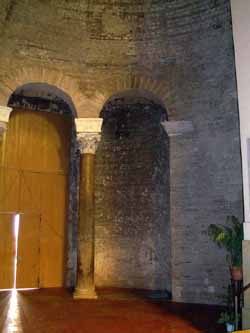 Still
on via Duomo and not far from the Cathedral is the church of
San Giorgio Maggiore. Its proximity to the Duomo may account for the
neglect that this house of worship has suffered over the centuries.
San Giorgio Maggiore is one of the oldest churches in the city; indeed,
it is truly “paleo-,” one of those churches built in the
early centuries of Christianity in Italy and that disappeared or were
covered over by newer buildings in the great age of cathedral building
after the turn of the millennium. Still
on via Duomo and not far from the Cathedral is the church of
San Giorgio Maggiore. Its proximity to the Duomo may account for the
neglect that this house of worship has suffered over the centuries.
San Giorgio Maggiore is one of the oldest churches in the city; indeed,
it is truly “paleo-,” one of those churches built in the
early centuries of Christianity in Italy and that disappeared or were
covered over by newer buildings in the great age of cathedral building
after the turn of the millennium.
You enter
the church from a small square on the north side of the building, take
a few steps and, at first, get the impression that you are in just another
17th–century Neapolitan church. Yet, when you turn, you see that
your few steps have taken you through a primitive apse of unadorned
masonry (photo), the small columns and vaulted dome of which are obviously
much older than the rest of the building. Indeed, they are—by
a thousand years. The original San Giorgio Maggiore is from about the
year 600 a.d. and all that is left of it is that tiny bit that is so
easy to overlook as you go inside.
The present
large church is from the 1600s when the decision was made to raze the
older building, incorporating a small token of it into the newer church.
Then, much of that newer building was subsequently demolished during
the urban renewal of Naples in the late 1800s when via Duomo—the
major road outside the church—was widened.
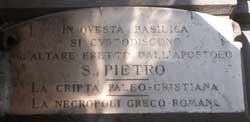 One
of the most fascinating examples of early Christianity in Naples is,
however, one which for some reason doesn't get a lot of press or tourist
attention. Yet, if what tradition says about this church is true, then
it is most certainly the site of the earliest instance of Christian
worship in Naples—or, for that matter, one of the earliest
anywhere. Hidden away off of Corso Umberto near Piazza Garibaldi
is the Church of San Pietro ad Aram. "Pietro," of course, refers
to the apostle Peter, the "rock" upon whom Christ said He would found
His church. "Aram" is the biblical name for parts of Mesopotamia and
Syria. The word is still found today in reference to the Aramaic language
of that region. Neapolitan tradition (and the plaque on the outside
of the church [photo]) says that Peter left Antioch on his way to Rome
nine years after the death of Christ. He stopped in Naples and held
a worship service on a rudimentary make-shift altar. Twenty centuries
later, beneath the countless changes wrought during all those fleeting
human ages that we flatter with such names as Medieval, Renaissance,
Baroque, etc., that altar—again, according to tradition—is
still there. One
of the most fascinating examples of early Christianity in Naples is,
however, one which for some reason doesn't get a lot of press or tourist
attention. Yet, if what tradition says about this church is true, then
it is most certainly the site of the earliest instance of Christian
worship in Naples—or, for that matter, one of the earliest
anywhere. Hidden away off of Corso Umberto near Piazza Garibaldi
is the Church of San Pietro ad Aram. "Pietro," of course, refers
to the apostle Peter, the "rock" upon whom Christ said He would found
His church. "Aram" is the biblical name for parts of Mesopotamia and
Syria. The word is still found today in reference to the Aramaic language
of that region. Neapolitan tradition (and the plaque on the outside
of the church [photo]) says that Peter left Antioch on his way to Rome
nine years after the death of Christ. He stopped in Naples and held
a worship service on a rudimentary make-shift altar. Twenty centuries
later, beneath the countless changes wrought during all those fleeting
human ages that we flatter with such names as Medieval, Renaissance,
Baroque, etc., that altar—again, according to tradition—is
still there.
Is it true?
I haven't the slightest idea, but 2,000 years doesn't seem like such
a long time to me any more. After all, I can reach over and touch bits
and pieces of stone walls and buildings near my house that were put
in place 500 years before that. Traditions, however, do have other functions
than simply being true; they serve as a means to bring religious and
social values into focus, and they help us appreciate our past and evaluate
what we believe. In those terms, true or not, the tradition surrounding
San Pietro ad Aram is a worthy one.
Croce,
Benedetto (2)
Villa Tritone in Sorrento
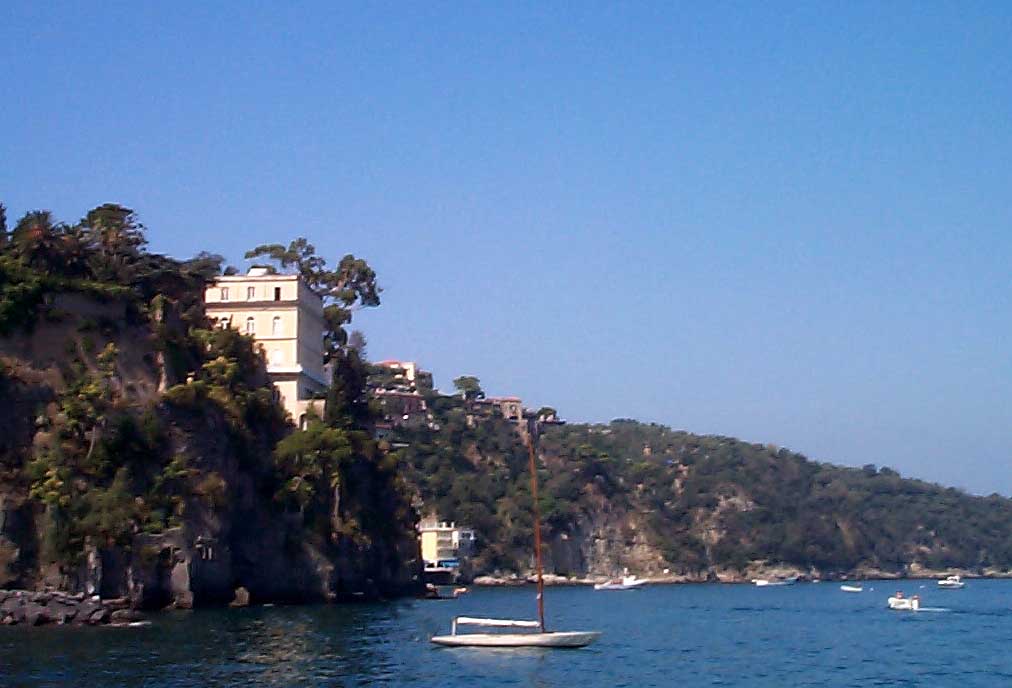 When
I heard the story the first time, it seemed too good to be true. Someone
mentioned to me Raleigh Trevelyan's book Rome'44, The Battle for
the Eternal City, in which —according to my second-hand source—there
is mention of a daring commando raid up a seaside cliff in Sorrento
to save the anti-regime historian and philosopher, Benedetto Croce, from the clutches of the nefarious
Germans in WW2. Said Nazis were going to take Croce hostage and
force him to eulogize the philosopher of the regime, Giovanni Gentile,
who had just been assassinated. The raid was carried out by a paramilitary
force that included the son of Axel Munthe, a long-time Capri resident,
author, and builder of the mansion that bears his name on the island. When
I heard the story the first time, it seemed too good to be true. Someone
mentioned to me Raleigh Trevelyan's book Rome'44, The Battle for
the Eternal City, in which —according to my second-hand source—there
is mention of a daring commando raid up a seaside cliff in Sorrento
to save the anti-regime historian and philosopher, Benedetto Croce, from the clutches of the nefarious
Germans in WW2. Said Nazis were going to take Croce hostage and
force him to eulogize the philosopher of the regime, Giovanni Gentile,
who had just been assassinated. The raid was carried out by a paramilitary
force that included the son of Axel Munthe, a long-time Capri resident,
author, and builder of the mansion that bears his name on the island.
As with
most second-hand tellings of third-hand readings from those who know
someone who read the book, the story was a mish-mash, and without having
consulted Trevelyan's book, I am quite willing to give him the benefit
of the doubt that that is not quite what he said.
The most
obvious mess is the connection to Gentile. The relationship between
Croce and Gentile is (1) beyond the scope of this brief entry and (2)
beyond my own poor powers of historical deconstruction. I do know that
they founded a journal together in the 1920s but then went their separate
ways when Gentile drafted the "Declaration of Fascist Intellectuals".
Croce was an anti-Fascist and spent most of the 1930s and WW2 being
hounded by regime goons. As far as this episode is concerned, Gentile
was murdered in 1944 and Croce's flight from Sorrento took place in
September of 1943. So, that part of it is out, but the real story isn't
half-bad, either.
Crose deals
with the episode in question in a small volume that I have finally had
a chance to consult. It is entitled Quando l'Italia era tagiata in
due: estratti di un diario (When Italy was cut in two: Extracts
from a Diary) and contains daily entries from July 1943 through June
1944. The book (published by Laterza in Bari in 1948) is strangely out
of print but was recently reprinted as a photographic copy in a limited
edition by Mario Pane, the owner of Villa Tritone in Sorrento, the cliff-top
mansion where Croce was living when the episode occurred. Croce had
left his residence, the Palazzo Filomarino
della Rocca in the historic center of town, and gone to Sorrento
to get away from the Allied air-raids of Naples. He moved into the Villa
Tritone, a splendid building set on a cliff in Sorento, overlooking
the sea (see photo, above). He was—as he had been in Naples—watched
by the authorities, but house arrest in the Villa Tritone does
beat a bare-bones prison cell.
He originally
published these diary excerpts in his Quaderni della Critica
in 1946 and 1947 "to correct misconceptions already starting to appear"
in the popular press about what had happened in Italy during that period
when "only the south" was in the hands of a true Italian government;
that is, the Germans were still in control in the north and had even
founded their puppet Italian Fascist Republic of Salò.
In his
entry for August 5, 1943, Croce sadly notes the "horrible destruction"
of the venerable Church of Santa Chiara,
directly across the street from his home. On September 3, he notes the
Anglo-American invasion of Calabria from Sicily.
On September
8, Croce mentions the official surrender of Italy to the Allied Forces
in the south. [At that point, the new Italian head-of-state Pietro Badoglio
went on the radio to tell the citizenry that "the battle continues"—against
the Germans and Italian Fascists. Italy was thus plunged into a civil
war.] The Germans, of course, did not simply pick up and move north;
they fought a very bitter campaign back up the boot of Italy. Three
days after the armistice of September 8, the Germans entered and occupied
Naples, which Croce mentions in his diary for that day. Croce mentions
on September 12 the spectacular rescue of Mussolini from his prison
on Gran Sasso in the mountains of the Abruzzi by a glider-borne team
of German commandos under Otto Skorzeny.
Through
all of this, Croce's notes betray no great concern for his personal
safety. He ploughed ahead with his considerable intellectual output,
working on, say, the poetry of Dante at virtually the same time as the
Allies were blowing the bridge at Seiano, a few miles further in on
the Sorrentine peninsula. On September 13, Croce writes for the first
time that he has received anonymous notes threatening himself and his
family, also living at Villa Tritone. On the next day, he reports
that there is confusion in Sorrento—no German troops, no Anglo-American
forces, but a lot of die-hard Fascists roaming the streets. His advisors
tell him that he has to leave immediately. Germans—who can still
come over the hills from Salerno—or home-grown Fascists in Sorrento
might like nothing better than to take him hostage and use him for propaganda
purposes. Croce writes, "I said that there were practical and moral
reasons why I couldn't leave. I didn't want a flight on my part to incite
panic among the populace." On the other hand, he notes with distaste
the uses to which his name might be put by a regime that he has detested
for so many years.
Then, suddenly,
the next day's entry, September 15, is written on Capri. Croce recounts
the events of the previous evening, when a floating mine was found in
the waters below the Villa. Forces intent on taking him and his family
hostage may be setting the stage. The retreating Germans really may
come to take him, the way they have already taken other prominent Italian
civilians in Salerno as they retreated. He has to go—now.
Croce relents and agrees to be taken to Capri—firmly in Allied
hands—in a motorboat that has come from that island. He leaves
at nine in the evening with three of his daughters as well as with a
police commissioner from Capri and an English officer, both of whom
have come from the island to rescue him. Croce leaves his wife and one
daughter behind to gather up the few things they will need later. He
reports the next day that the boat sent back to Sorrento from Capri
to pick up his wife and daughter has turned back because of the rumor
that the Germans have already invaded the villa and taken the rest of
his family. That rumor turns out to be false and on September 17, the
same boat, with the same police commissioner, this time accompanied
by a "Major Munthe (the son of Axel Munthe)" returns successfully and
picks up his wife and daughter.
The next
day, he is questioned by an English officer for names of "dangerous
persons and Fascists" left in Sorrento. He says he is not about to start
doing what he has refused to do for so many years—collaborate.
Through the whole episode, Croce is deeply saddened—and it comes
through even in his low-key prose—that his nation is cut in two
and he clearly does not want to fuel the fires of acrimony and vendetta
by naming names.
Later in
the week, he writes, the Italian Fascist and German radio stations state
that "Croce and others, who have tried the patience of the regime, will
be severely punished." At that, the Allies broadcast the news that Croce
is safe on Capri. So, there was no great derring-do or cliff-climbing—unnecessary
since Villa Tritone has its own stairs down to a private boat
landing—but nevertheless, it's a very human drama.
San
Ferdinando (church)
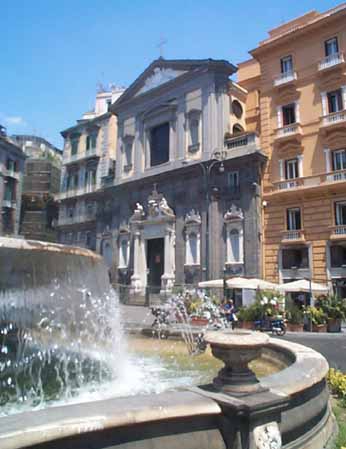 The everchanging nomenclature of Neapolitan streets
and squares now calls it Piazza Trieste e Trento, but the square
at the Royal Palace end of via Roma
used to be Piazza San Ferdinando, a name that still defines that
entire area of the city. The area takes its name from the Church of San
Ferdinando, adjacent to the Galleria Umberto
and directly in front of the large fountain in the center of the square.
It is often the first church that visitors to Naples see when they walk
up past the San Carlo opera to have a look at Piazza
Plebiscito. The everchanging nomenclature of Neapolitan streets
and squares now calls it Piazza Trieste e Trento, but the square
at the Royal Palace end of via Roma
used to be Piazza San Ferdinando, a name that still defines that
entire area of the city. The area takes its name from the Church of San
Ferdinando, adjacent to the Galleria Umberto
and directly in front of the large fountain in the center of the square.
It is often the first church that visitors to Naples see when they walk
up past the San Carlo opera to have a look at Piazza
Plebiscito.
The plans
for the church were drawn up in 1622 by the Society of Jesus (the Jesuits), and the church was
opened in 1665 after some years of interrupted construction. It was
originally dedicated to St. Francis Xavier (San Francesco Saverio, in
Italian) friend of St. Ignatius Loyola and one of the members of the
first company of Jesuits. The interior of the church still displays
numerous works of art depicting the life and missionary activities of
St. Francis Xavier, including a —by today's ecumenical
standards—"politically incorrect" painting of The Triumph
of Religion over Heresy through St. Ignatius, St. Francis Xavier, St.Francis
Borgia and the three Japanese martyrs, while Mohammed is cast down with
the Koran. Some prominent works have gone missing over the centuries,
including a painting by Salvator Rosa, or have been moved to other premises
(such as a painting by Luca Giordano that is now at the Capodimonte
Museum). The church was rededicated to San Ferdinando when the Jesuits
were expelled from Naples in 1767. The façade of the church has
recently undergone restoration.
Madre
del Buon Consiglio
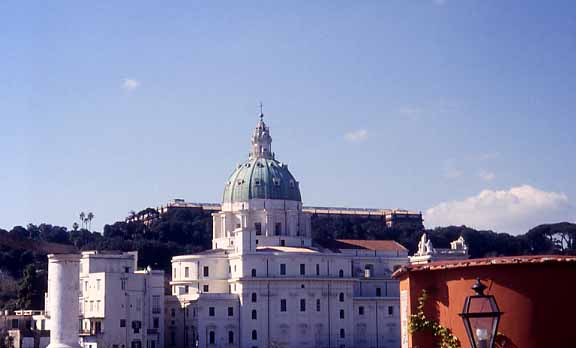 Perched on the hillside leading up to the Capodimonte
Palace and very visible from various quarters of Naples is the church,
Madre del Buon Consiglio. Interestingly, it is not nearly
as old as it looks. It was built in the years between 1920 and 1960
in imitation of St. Peter's in the Vatican. It houses a number of works
of art rescued from closed, damaged, or abandoned houses of worship
in the city. There is also a path leading down to the catacombs
of Naples. Legend has already attached itself to the church: the earthquake
of 1980 toppled the head of the statue of the Madonna from the top of
the church to the ground, where it crashed and lay inexplicably undamaged. Perched on the hillside leading up to the Capodimonte
Palace and very visible from various quarters of Naples is the church,
Madre del Buon Consiglio. Interestingly, it is not nearly
as old as it looks. It was built in the years between 1920 and 1960
in imitation of St. Peter's in the Vatican. It houses a number of works
of art rescued from closed, damaged, or abandoned houses of worship
in the city. There is also a path leading down to the catacombs
of Naples. Legend has already attached itself to the church: the earthquake
of 1980 toppled the head of the statue of the Madonna from the top of
the church to the ground, where it crashed and lay inexplicably undamaged.
Basile,
Giambattista (1575-1632) and The Tale of Tales
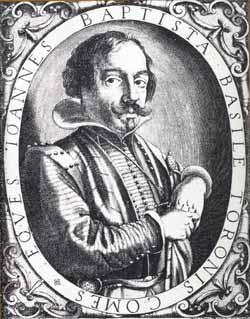 European
nation states are now so well grounded in their respective national
languages that we often overlook what a vibrant history many non-standard
languages —"dialects"— have. Perhaps the recent (1976)
granting of linguistic autonomy in Spain to three minority languages
—Galician, Catalonian, and Basque— is a sign of some
sort of backlash in Europe against overbearing language hegemony,
or, at least, a recognition of the importance of smaller languages
in the lives of people. It is, at least, an excellent example of
how to defuse an issue often touted as potentially explosive—the
rights of linguistic minorities. European
nation states are now so well grounded in their respective national
languages that we often overlook what a vibrant history many non-standard
languages —"dialects"— have. Perhaps the recent (1976)
granting of linguistic autonomy in Spain to three minority languages
—Galician, Catalonian, and Basque— is a sign of some
sort of backlash in Europe against overbearing language hegemony,
or, at least, a recognition of the importance of smaller languages
in the lives of people. It is, at least, an excellent example of
how to defuse an issue often touted as potentially explosive—the
rights of linguistic minorities.
The
language of Naples—officially, of course—is Italian.
It's what newscasters speak, it's the language of the print media
and it's what kids learn in school. It is the national language
of Italy because of its glorious literary tradition going back to
the language of Dante and Boccaccio in 1300. It is the official
language of Naples because southern Italy was made part of the rest
of Italy by a series of wars in the 19th century, generally called
"The Wars of Unification" in history books. The spoken language
of most of the people in Naples, however, is the Neapolitan
dialect, that southern brand of Latin vernacular with as long a
history as the northern Tuscan vernacular upon which the national
language is based.
[For
a
separate item on the Neapolitan language]
In the
group of southern Italian literary figures since the Middle Ages who
have expressed themselves in their native, southern language, one of
the most important is Giambattista Basile, the author of Il Pentamerone
or Li Cunto de li Cunti (The Tale of Tales), known in English
as, simply, The Pentameron. It is the first published collection
of European fairy tales. It is a frame-story like Chaucer's Canterbury
Tales and Boccaccio's Decameron; that is, the telling of
tales is presented within the framework of a group of people passing
the time by sharing stories. Basile's Pentamerone tells fifty
tales over five nights, all of them in Neapolitan. The most famous of
the tales is Zezolla, also known as "The Cat Cinderella,"
apparently the first published version of the famous fairy-tale, better
known to English-language readers in a translation of the later French
version by Perault.
Basile
was born in Naples and lived and wrote there. He also traveled to and
wrote in Venice and Mantua, but always returned to Naples, where he
was the court poet for various families of the nobility, including that
of Stigliano Carafa. By 1620 he was among the most respected Neapolitan
writers, known for both madrigals and odes in Italian as well as poetry
in Neapolitan.
A
German-language edition of The Pentameron
 It is, however,
for The Pentameron that he is remembered. It is a valuable source
for those who today study such things as comparative folk-tales in an
attempt to pin down themes that crop up almost universally across cultures.
At the time of Basile's death in 1632, no such lofty ambitions engaged
most people, least of all Basile's sister, who put the collection of
fairy tales on the back shelf somewhere while she tried to get her brother's
other works in Italian some posthumous attention. Fortunately, that
back shelf was on the premises of a local book-shop, the proprietor
of which had a great love for literature in the vernacular; within a
couple of years, the first few Neapolitan tales were published and by
1644 a complete version was published. It is, however,
for The Pentameron that he is remembered. It is a valuable source
for those who today study such things as comparative folk-tales in an
attempt to pin down themes that crop up almost universally across cultures.
At the time of Basile's death in 1632, no such lofty ambitions engaged
most people, least of all Basile's sister, who put the collection of
fairy tales on the back shelf somewhere while she tried to get her brother's
other works in Italian some posthumous attention. Fortunately, that
back shelf was on the premises of a local book-shop, the proprietor
of which had a great love for literature in the vernacular; within a
couple of years, the first few Neapolitan tales were published and by
1644 a complete version was published.
The
Pentameron was relatively late in finding a broader audience through
translation, almost certainly because of the linguistic difficulties
of the original version. Translators often worked from fragmentary French
versions done in the 1700s. Complete versions in German and English
did not appear until the early 1800s. Interestingly, a complete translation
with scholarly notes in Italian (the original Neapolitan is hopelessly
foreign to those in northern Italy) did not appear until 1920s when
Benedetto Croce turned his attention to it. "The Cat Cinderella" tale
in The Pentameron has gained more recent acclaim through the
efforts of Neapolitan musicologist, Roberto De Simone, whose staged
version of the tale has appeared throughout Europe in various languages.
One might
ask, Why would a poet who wrote odes and madrigals in Italian be fascinated
enough by dialect fairy-tales to devote so much of his life to collecting
them and writing them down? Not that everything needs to be explained,
but at least one version says that Basile was more than a little uncomfortable
with the opulence of the Baroque. He worked at the noble courts of Naples
in the early 1600s —a time and place when the rich were very rich
and the poor very poor. He had the reputation of being a modest
person who went out of his way to be honest and to avoid displays of
whatever wealth he possessed. Maybe, too, he was just fascinated by
tales in which simplicity is a virtue, ones in which good is rewarded
and evil punished. Or, maybe, he just liked a good story, like the rest
of us:
| There
was in that land an enchanted Prince so attracted by Nella's beauty
that he married her in secret. And in order that they might
see one another without arousing the suspicion of her wicked mother,
the Prince crafted a crystal passage from the royal palace directly
to Nella's abode, although it was many miles distant. Then he
gave her a magic powder saying, "Whenever you wish to see me,
throw a little of this powder into the fire, and I will come to
you instantly through this passage, as quick as a bird, along
the crystal road to gaze upon this face of silver.
—from
"The Three Sisters" in The Pentameron by Giambattista
Basile
|
That's
hard to beat.
Odessa
(ship)
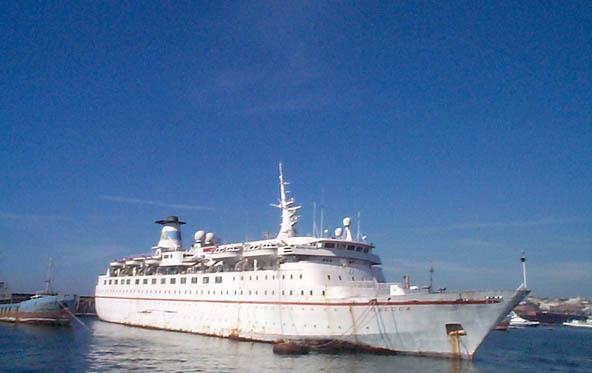 This ship docked at the port of Naples
had become somewhat of a landmark, but it was becoming rustier and less
seaworthy with each passing month and year that it sat there. The Odessa
was built in 1970-74 in Newcastle, UK. She was 136 meters long, did
19 knots and carried 550 passengers and 265 crew. The Odessa
was once the proud flagship of the Soviet cruise fleet, and, indeed,
I remember it coming into Naples on a number of occasions in the 1980s.
At the time, Soviet tourists were an oddity in Naples. One time I went
down to the port to meet Viktor, a trombone-player friend of mine on
tour with the then Leningrad (now, St. Petersburg) Philharmonic. He
walked up smiling and wearing a watch on each wrist. He had been waylaid
by a dockside vendor, but he seemed content—and I'm sure the vendor
was. (I heard later that both watches gave up the ghost halfway through
the second movement of Shostakovitch's 5th symphony later that evening.)
Anyway, Viktor had arrived on the good ship Odessa. This ship docked at the port of Naples
had become somewhat of a landmark, but it was becoming rustier and less
seaworthy with each passing month and year that it sat there. The Odessa
was built in 1970-74 in Newcastle, UK. She was 136 meters long, did
19 knots and carried 550 passengers and 265 crew. The Odessa
was once the proud flagship of the Soviet cruise fleet, and, indeed,
I remember it coming into Naples on a number of occasions in the 1980s.
At the time, Soviet tourists were an oddity in Naples. One time I went
down to the port to meet Viktor, a trombone-player friend of mine on
tour with the then Leningrad (now, St. Petersburg) Philharmonic. He
walked up smiling and wearing a watch on each wrist. He had been waylaid
by a dockside vendor, but he seemed content—and I'm sure the vendor
was. (I heard later that both watches gave up the ghost halfway through
the second movement of Shostakovitch's 5th symphony later that evening.)
Anyway, Viktor had arrived on the good ship Odessa.
Then, time
passed, and suddenly—or so it seemed—the Odessa was
just there all the time in the port. A few weeks ago, I ferried
out of the port on my way to Sorrento, looked over at the usual place
and she was gone. As it turned out, the ship had stayed for seven years;
I had just lost track of the time.
When the
Soviet Union broke up, 200 ships were taken over by the Black Sea Shipping
Company (BLASCO) operating out of the port of Odessa in the Ukraine.
By the spring of 1995, Blasco owed 300 million dollars to its creditors
and was so far in debt that 24 of the company's ships were seized in
ports around the world. At the demand of a German creditor, the Odessa
was "arrested" (the term used in Admiralty law) on a cruise at Capri.
There were 360 passengers on board at the time. They disembarked in
Naples, and the ship was forbidden to set sail. (In such cases, port
authorities carrying out the "arrest," physically board the ship and
place a lock and chain around the wheel and post a warrant.)
The war
of attrition between the creditors and the skeleton crew left on board,
commanded by Captain Vladimir Lobanov, began. The Captain retained a
sense of humor throughout the affair, at one point telling reporters
that the crew was doing much better "now that all the rats have starved
to death". Most of the crew left, but the nine crew members who stayed
had a claim against the vessel and decided to tough it out in the hopes
of some day not having to return home totally penniless from the ordeal.
As in the cases of some of the Odessa's sister ships in
ports around the world, the plight of the crew attracted the sympathy
and solidarity of port workers, who took them food. In 1999, one of
the crew died in his cabin of a heart attack.
I now read
that the Odessa was auctioned off in April of 2002 for 1,250,000
euros, 500,000 euros of which was designated for the eight surviving
crew members. I read that the Odessa is again in its home port
on the Black Sea undergoing refitting for another try at the cruise
game.
Castles,
old
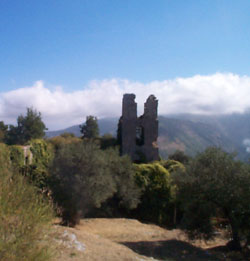 (This
ruin is high above the town of Pimonte at the beginning of the Sorrentine
peninsula.) (This
ruin is high above the town of Pimonte at the beginning of the Sorrentine
peninsula.)
Just another
old castle? Well, yes and no. Yes, the area around Naples—like
much of Europe—is dotted with ruins of medieval castles,
some of which have been fixed up for you to see, but most of which are
in various states of disrepair. The latter are the kind you are likely
to dismiss as "just another castle" as you whiz by them on modern highways. No,
on the other hand, if you realize that at the time they were built,
these castles served specific purposes and were manifestations of long
and complicated historical processes: the fall of Rome, the struggle
between Byzantium and the West for control of Italy, the birth of the
Holy Roman Empire, the beginnings of feudalism, etc.
Thus, stepping
back and taking a closer look at some of these structures near Naples—those
restored as well as those in ruins—gives some insight into
a period often glossed over as the "Middle Ages." The gloss covers chivalry,
chicanery, knights, codpieces, maidens and castles, but often skips
the events that have shaped modern Europe.
There are
a number of such castles as you drive east out of Naples on the autostrada
approaching the Sorrentine peninsula and again on the peninsular road
itself. First, on the left as you approach the Salerno-Sorrento junction
is the castle of Lettere. The castle and the town of Lettere are perched
at 400 meters on the western slope of the Lattari mountain range, the
backbone of the Sorrentine peninsula that then joins the main Apennine
range further east. The turrets and ramparts of the old castle are still
quite discernible from the road. It is not exactly a falling-down ruin;
i.e. at least the outer shell is still intact. However, the castle cannot
be entered easily—or entirely safely, for that matter.
The interior is overgrown and pretty much in shambles. It looks restorable,
however, and they talk about that all the time, since it is, at
least potentially, a tourist attraction. It was built in the 9th
century on the site of an older Roman fort on that strategic height,
a fortress that at times hosted no less than Roman dictator Sulla as
well as later emperors. (There has been scaffolding on the outer walls
for a number of months, so maybe a restored castle is in the offing.)
| This
print by 18th-century artist, J.L. Phillipe Coignet, shows Vesuvius
as seen from the ruins of the old Castellammare ("Castle on the
sea"). |
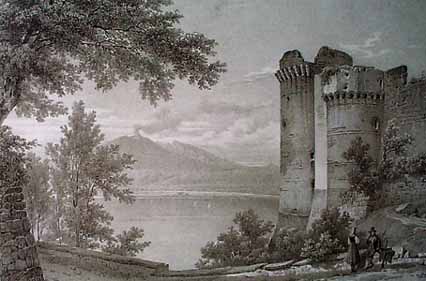 Moving
out onto the peninsula, you pass through two tunnels and then down the
road onto the coast. On that road is a fine and solid, new-looking
castle on your right as you drive out. It is in such good shape—clearly
lived in—that it belies its age. This is the castle of
Castellammare di Stabia; that is, the castle that the city of
Castellammare ("Castle on the Sea") was named for. It is at the base
of the ridge below Monte Faito. The modern town below the castle sits
on Greek, Etruscan, Samnite and Roman ruins, the Romans being the ones
who gave the name Stabia to the site. The castle has been rebuilt
many times over the centuries, the last time in 1956 to make it habitable.
It is first mentioned in the 1000s as having been built at the behest
of the Duke of Salerno (of which more, below). Also, not visible at
all from the road, but there nonetheless, are a few smaller structures
well up on the hillside, such as the castle of Pino at 500 meters above
sea level. It is accessible from the road that passes over the mountain
from Castellammare to Agerola. And there are other smaller ruins scattered
along the western side of the Lattari range. Moving
out onto the peninsula, you pass through two tunnels and then down the
road onto the coast. On that road is a fine and solid, new-looking
castle on your right as you drive out. It is in such good shape—clearly
lived in—that it belies its age. This is the castle of
Castellammare di Stabia; that is, the castle that the city of
Castellammare ("Castle on the Sea") was named for. It is at the base
of the ridge below Monte Faito. The modern town below the castle sits
on Greek, Etruscan, Samnite and Roman ruins, the Romans being the ones
who gave the name Stabia to the site. The castle has been rebuilt
many times over the centuries, the last time in 1956 to make it habitable.
It is first mentioned in the 1000s as having been built at the behest
of the Duke of Salerno (of which more, below). Also, not visible at
all from the road, but there nonetheless, are a few smaller structures
well up on the hillside, such as the castle of Pino at 500 meters above
sea level. It is accessible from the road that passes over the mountain
from Castellammare to Agerola. And there are other smaller ruins scattered
along the western side of the Lattari range.
Many of
these castles have a common link. In 774 Charlemagne entered Rome, and,
in so doing, took over Lombard holdings in northern Italy and,
as well, established his authority over the new Vatican States of central
Italy. Thus ended the 200-year Lombard kingdom that had ruled
most of Italy since shortly after the fall of the Roman Empire. Then,
in 800 Charlemagne had himself crowned with the very crown of the Lombard
kings, proclaiming the end of one kingdom and the beginning of another,
the Holy Roman Empire.
This description
leaves out an important item, one that is crucial to understanding the
next 1000 years of Italian history: Charlemagne didn't get the job done.
He failed in his Justinian-like quest to reunite Italy. Charlemagne
spent much of the late 700s fighting Saxons and Moors elsewhere, but
in Italy he was content to leave the southern half of the peninsula
still solidly in the hands of the Lombards. Left to its own devices,
southern Italy became the large Lombard Duchy of Benevento. It was not
a monolithic political unit, but the Lombards had always been loose-knit
in Italy, anyway, governing as more of a confederation than a single
state. Starting in the early 800s, then, from south of Rome all the
way down the peninsula, and centering on the town of Benevento, the
Lombards continued to hold sway in the south. Thus began the division
of Italy into north and south, a division that would not be healed until
1860.
The castles
mentioned in this article came into being directly because of events
in the mid-800s. The Duchy of Benevento underwent a civil war in the
830s. The war was ended by a treaty in 839 that established a separate
Duchy of Salerno. This left the Sorrentine peninsula and the area
above the Sarno valley in a volatile state. Three duchies were
now contiguous: the independent Duchy of Naples, the still vast (in
spite of the civil war) Duchy of Benevento, and the new Duchy of Salerno.
They all came together in these mountains. Salerno,
to keep her neighbors honest, started building forts on the western
slopes to keep both Naples and Benevento at bay. Both the castle of
Lettere and the one at Castellammare are from that period, as are the
smaller ones mentioned above.
The castles
did their job until the coming of the Normans in the 11th century. Coming up the boot
from their newly-founded Kingdom of Sicily, they fused Southern Italy
into a single unit, beginning the modern Kingdom of Naples that would
last until 1860. The various castles that had helped cement in place
the fragmentation of the south into smaller units passed into the hands
of feudal landlords—the dukes and barons—who
then ruled their smaller fiefdoms while pledging loyalty to the king
of Naples. Many of the structures were of strategic, military importance
well past the "age of castles". They served into the 16th and even 17th
century and were important in protecting the coastal areas of Naples
from marauding bands of Saracens, Moslem pirates who plagued southern
Italy for many centuries.
Pontano Chapel
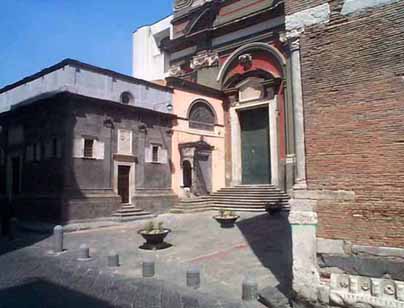 The Pontano Chapel is the small grey building at the
western end of Via Tribunali in the historic center of the city (#37
on the map of the historic center). The perfect classic Roman
design is attributed to Giocondo da Verona and was built in 1492 by
Giovanni Pontano to be a family chapel. The Pontano Chapel is the small grey building at the
western end of Via Tribunali in the historic center of the city (#37
on the map of the historic center). The perfect classic Roman
design is attributed to Giocondo da Verona and was built in 1492 by
Giovanni Pontano to be a family chapel.
Pontano
(1426-1503) was the most celebrated Neapolitan humanist of the day,
a friend of the sovereign of Naples, Alphonso the Magnanimous, and,
indeed, tutor of the king's sons. He was important as a diplomat for
the Aragonese in Naples, but his claim upon history is as a poet and
scholar. Pontano is often referred to as the last great poet in the
Latin language. He founded in Naples what was called "The Academy"
—a meeting place for the erudite. The Academy was
influential among men of letters not only in the Kingdom of Naples,
but elsewhere in Italy. Subsequently it became known as the Pontanian
Academy, and its influence lasted well beyond the lifetime of the founder.
Belfry, oldest
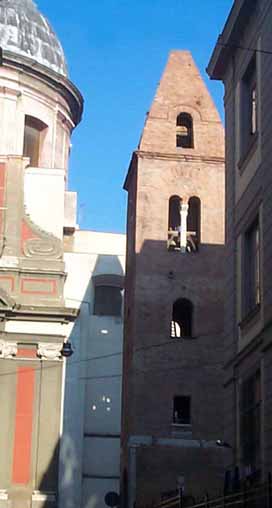
Adjacent
to that chapel is the church of S. Maria Maggiore della Pietrasanta.
It was built in 533 and is one of the paleo-Christian churches in Naples. Its origins involve
one of the weirdest tales of ancient Naples. In 533, the Virgin Mary
is said to have appeared to Bishop Pomponius of Naples and commanded
him to chase away a swine possessed of the devil that had been frightening
citizens of the area. He did and then built and consecrated this church
on the site of an earlier temple dedicated to Diana. The church was
considered one of the most impressive examples of early Christian architecture.
The relatively modern appearance of the church is due to the reconstruction
of 1653.The remarkable red-brick belfry (photo, right) on the grounds
is the oldest free-standing tower of its kind in Naples. It was part
of the original church complex, though built later (c. 900 a.d.). The
base of the tower (upper photo) incorporates earlier Roman bits and
pieces as contruction material, some of which are said to be part of
the earlier temple.
San
Gennaro (1)
'Ha
fatto il miracolo?' 'Did
he perform the miracle?'
| Statue
of S. Gennaro at the entrance to the port of Naples |
 Neapolitans
have asked themselves that question any number of times throughout their
history. A few days after Giuseppe Garibaldi
entered Naples (thus ending the 800-year history of the Kingdom of Two
Sicilies and creating modern Italy in the process), San Gennaro (St.
Januarius), the patron saint of the city, indeed, performed the wonder
right on schedule. Solid remnants of the martyred saint's blood, contained
in a vial in the Cathedral of Naples,
miraculously and mysteriously liquefied on September 19, 1860, and,
thus conferred, according to popular belief, divine benediction on Garibaldi's
victory. Neapolitans
have asked themselves that question any number of times throughout their
history. A few days after Giuseppe Garibaldi
entered Naples (thus ending the 800-year history of the Kingdom of Two
Sicilies and creating modern Italy in the process), San Gennaro (St.
Januarius), the patron saint of the city, indeed, performed the wonder
right on schedule. Solid remnants of the martyred saint's blood, contained
in a vial in the Cathedral of Naples,
miraculously and mysteriously liquefied on September 19, 1860, and,
thus conferred, according to popular belief, divine benediction on Garibaldi's
victory.
On the
other hand, there is a story they tell from the days of the Neapolitan
(or Parthenopean) Republic, the sister Republic of revolutionary
France, and one that lasted a mere five months in 1799. On the first
Sunday in May, the other time when the miracle is said to occur, it
didn't. This provoked the French commander—desperate to win popular
support for his troops occupying the city— into the interesting
move of threatening to kill the Archbishop of Naples if the sign from
Heaven were not forthcoming. A short while later it came forth, thus
lending, at least in the mind of the French general— and notwithstanding
skeptical popular charges of pseudo-divine hanky-panky—
credence to his claim that God was on the side of the Revolution.

(Interestingly, this led to the temporary displacement of Gennaro as
the patron saint of Naples in the hearts of loyalist Neapolitans. There
are a number of paintings showing St. Anthony at the head of the army
of the Holy Faith, the Sanfedisti, as they enter the city
to retake it from revolutionaries in 1799. The illustration on the right
shows "the princes returning to Naples" under the watchful protection
of St. Anthony and not San Gennaro.)
San Gennaro
was the Bishop of Benevento and was beheaded at Pozzuoli in 304 during
Diocletian's persecution of the Christians. They had to chop his head
off, the story goes, because when they had thrown him to the lions once
before, the animals had refused to attack him and had simply crouched
in submission at his feet. His remains were taken to Napoli to be conserved.
The "miracle of San Gennaro," then, refers to the liquification of the
clotted blood of the saint. It is said to happen two times a year at
the Duomo (Cathedral) of Naples and at the Church of San Gennaro
at Solfatara in Pozzuoli, virtually on the spot where he was killed.
September 19 is the anniversary of his martyrdom. It is, thus, the saint's
name-day, as well, and Gennaro is the most common name given
to male babies born in Naples. Besides September 19 and the first Sunday
in May, some sources say the miracle may also occur on December 16,
in commeration of a violent explosion of Vesuvius, which spared the
city in the 1600s.
The granting
or withholding of the miracle by the saint is, in the minds of many
believers, intimately connected with the fortunes of the city--a prediction,
perhaps, of traumatic occurences such as war, pestilence and natural
calamity, or even something not so earthshaking, such as whether or
not Napoli will win the football championship. It might also
be a general notice of solidarity or disapproval from on high, as in
the cases noted above. The official position of the Roman Catholic Church,
which can, if it desires, make a pronouncement, on the validity of claims
of miraculous occurences, is one of neutrality. Of course, in this our
21st-century Age of Skepticism, one expects to find skeptics, even among
otherwise faithful, practicing Roman Catholic Neapolitans. But just
as Christian scriptures remind us that we do "not live by bread alone,"
there are those who would remind us that the same goes for a people
and a city; they couldn't have survived as long as they have without
a little help. If you are out and around on one of the dates when "it"
is supposed to happen, keep an eye on the reactions of those around
you. Notice how even the skeptics cannot conceal their relief upon hearing
that "San Gennaro ha fatto il miracolo!"
[If
you want to read Mark Twain's less benevolent view of the miracle of
San Gennaro, click here.]
|
This ship docked at the port of Naples
had become somewhat of a landmark, but it was becoming rustier and less
seaworthy with each passing month and year that it sat there. The Odessa
was built in 1970-74 in Newcastle, UK. She was 136 meters long, did
19 knots and carried 550 passengers and 265 crew. The Odessa
was once the proud flagship of the Soviet cruise fleet, and, indeed,
I remember it coming into Naples on a number of occasions in the 1980s.
At the time, Soviet tourists were an oddity in Naples. One time I went
down to the port to meet Viktor, a trombone-player friend of mine on
tour with the then Leningrad (now, St. Petersburg) Philharmonic. He
walked up smiling and wearing a watch on each wrist. He had been waylaid
by a dockside vendor, but he seemed content—and I'm sure the vendor
was. (I heard later that both watches gave up the ghost halfway through
the second movement of Shostakovitch's 5th symphony later that evening.)
Anyway, Viktor had arrived on the good ship Odessa.
 (This
ruin is high above the town of Pimonte at the beginning of the Sorrentine
peninsula.)
(This
ruin is high above the town of Pimonte at the beginning of the Sorrentine
peninsula.) Moving
out onto the peninsula, you pass through two tunnels and then down the
road onto the coast. On that road is a fine and solid, new-looking
castle on your right as you drive out. It is in such good shape—clearly
lived in—that it belies its age. This is the castle of
Castellammare di Stabia; that is, the castle that the city of
Castellammare ("Castle on the Sea") was named for. It is at the base
of the ridge below Monte Faito. The modern town below the castle sits
on Greek, Etruscan, Samnite and Roman ruins, the Romans being the ones
who gave the name Stabia to the site. The castle has been rebuilt
many times over the centuries, the last time in 1956 to make it habitable.
It is first mentioned in the 1000s as having been built at the behest
of the Duke of Salerno (of which more, below). Also, not visible at
all from the road, but there nonetheless, are a few smaller structures
well up on the hillside, such as the castle of Pino at 500 meters above
sea level. It is accessible from the road that passes over the mountain
from Castellammare to Agerola. And there are other smaller ruins scattered
along the western side of the Lattari range.
 The Pontano Chapel is the small grey building at the
western end of Via Tribunali in the historic center of the city (#37
on the map of the historic center). The perfect classic Roman
design is attributed to Giocondo da Verona and was built in 1492 by
Giovanni Pontano to be a family chapel.
The Pontano Chapel is the small grey building at the
western end of Via Tribunali in the historic center of the city (#37
on the map of the historic center). The perfect classic Roman
design is attributed to Giocondo da Verona and was built in 1492 by
Giovanni Pontano to be a family chapel.  Neapolitans
have asked themselves that question any number of times throughout their
history. A few days after Giuseppe Garibaldi
entered Naples (thus ending the 800-year history of the Kingdom of Two
Sicilies and creating modern Italy in the process), San Gennaro (St.
Januarius), the patron saint of the city, indeed, performed the wonder
right on schedule. Solid remnants of the martyred saint's blood, contained
in a vial in the Cathedral of Naples,
miraculously and mysteriously liquefied on September 19, 1860, and,
thus conferred, according to popular belief, divine benediction on Garibaldi's
victory.
Neapolitans
have asked themselves that question any number of times throughout their
history. A few days after Giuseppe Garibaldi
entered Naples (thus ending the 800-year history of the Kingdom of Two
Sicilies and creating modern Italy in the process), San Gennaro (St.
Januarius), the patron saint of the city, indeed, performed the wonder
right on schedule. Solid remnants of the martyred saint's blood, contained
in a vial in the Cathedral of Naples,
miraculously and mysteriously liquefied on September 19, 1860, and,
thus conferred, according to popular belief, divine benediction on Garibaldi's
victory. 
 In 330 a.d. a Christian
convert built a Christian city to replace the old and pagan Rome. His
—Constantine the Great's— faith would soon be proclaimed
the official religion of the Roman Empire. The bad news would be that
he had inadvertently made it possible for that Empire to be divided
in two, sundering its church right along with it.
In 330 a.d. a Christian
convert built a Christian city to replace the old and pagan Rome. His
—Constantine the Great's— faith would soon be proclaimed
the official religion of the Roman Empire. The bad news would be that
he had inadvertently made it possible for that Empire to be divided
in two, sundering its church right along with it.  On the north side
of the square is the Naples Prefecture (photo, right). It is on the
site of the old Convent of the Holy Spirit built in the early 1300s.
The clearing away of the monastery was part of the general campaign
by the French during the Napoleonic decade under Murat in Naples (1806-1815)
to, one, supress monastic orders and, two, rebuild the space in front
of the Royal Palace. This building was started in 1810, suspended when
the Bourbons returned to the throne of Naples in 1815, and then continued,
following the original plans. It is a "twin" of Palazzo Salerno,
the building facing it from directly across the square. That building
houses the Regional Military Command and, in spite of the identical
appearance, is older; it was built in 1775 by the Bourbons to house
a batallion of military cadets. Palazzo Salerno, however, was
then redone to look like the newer one in the photo as part of
the French and then Bourbon plan to rebuild the square. Actually, the
Prefecture is better known to most because it is adjacent to the Gambrinus
cafe, a favorite haunt of poets and musicians during the late 1800s
and early 1900s and, today, a favorite tourist attraction.
On the north side
of the square is the Naples Prefecture (photo, right). It is on the
site of the old Convent of the Holy Spirit built in the early 1300s.
The clearing away of the monastery was part of the general campaign
by the French during the Napoleonic decade under Murat in Naples (1806-1815)
to, one, supress monastic orders and, two, rebuild the space in front
of the Royal Palace. This building was started in 1810, suspended when
the Bourbons returned to the throne of Naples in 1815, and then continued,
following the original plans. It is a "twin" of Palazzo Salerno,
the building facing it from directly across the square. That building
houses the Regional Military Command and, in spite of the identical
appearance, is older; it was built in 1775 by the Bourbons to house
a batallion of military cadets. Palazzo Salerno, however, was
then redone to look like the newer one in the photo as part of
the French and then Bourbon plan to rebuild the square. Actually, the
Prefecture is better known to most because it is adjacent to the Gambrinus
cafe, a favorite haunt of poets and musicians during the late 1800s
and early 1900s and, today, a favorite tourist attraction.
 I don't know that
this is the world's greatest pasta shop, but I like it. Pasta comes
as spaghetti, macaroni, fettuccini, tagliatelle,
penne, rigate, vermicelli, capellini, anelli,
spirali, fusilli, maltagliatti, et noodle cetera
—and those are just some of the common, generic Italian noodles
in the present tense. Neapolitan conjugations include—but are
not limited to (as pasta-loving legal fleagles like to say) —ziti
and paccheri.) They come in red, green, white, and even the off-brown
of (ugh!) whole-wheat health-food pasta. Also, they are stubby, skinny,
straight, wavy, cork-screwy, and shaped like a torus, also known as
an "anchor ring" (or "donut" to non-mathematicians). Attempts to create
a stable double-torus noodle have thus far been unsuccessful. (See Dente,
Al. "Getting a Handle on a Trivial Tubular Neighborhood" in the Journal
of Pasta and Topology.) I think this shop has all of them.
I don't know that
this is the world's greatest pasta shop, but I like it. Pasta comes
as spaghetti, macaroni, fettuccini, tagliatelle,
penne, rigate, vermicelli, capellini, anelli,
spirali, fusilli, maltagliatti, et noodle cetera
—and those are just some of the common, generic Italian noodles
in the present tense. Neapolitan conjugations include—but are
not limited to (as pasta-loving legal fleagles like to say) —ziti
and paccheri.) They come in red, green, white, and even the off-brown
of (ugh!) whole-wheat health-food pasta. Also, they are stubby, skinny,
straight, wavy, cork-screwy, and shaped like a torus, also known as
an "anchor ring" (or "donut" to non-mathematicians). Attempts to create
a stable double-torus noodle have thus far been unsuccessful. (See Dente,
Al. "Getting a Handle on a Trivial Tubular Neighborhood" in the Journal
of Pasta and Topology.) I think this shop has all of them.

 Still
on via Duomo and not far from the Cathedral is the church of
San Giorgio Maggiore. Its proximity to the Duomo may account for the
neglect that this house of worship has suffered over the centuries.
San Giorgio Maggiore is one of the oldest churches in the city; indeed,
it is truly “paleo-,” one of those churches built in the
early centuries of Christianity in Italy and that disappeared or were
covered over by newer buildings in the great age of cathedral building
after the turn of the millennium.
Still
on via Duomo and not far from the Cathedral is the church of
San Giorgio Maggiore. Its proximity to the Duomo may account for the
neglect that this house of worship has suffered over the centuries.
San Giorgio Maggiore is one of the oldest churches in the city; indeed,
it is truly “paleo-,” one of those churches built in the
early centuries of Christianity in Italy and that disappeared or were
covered over by newer buildings in the great age of cathedral building
after the turn of the millennium.  One
of the most fascinating examples of early Christianity in Naples is,
however, one which for some reason doesn't get a lot of press or tourist
attention. Yet, if what tradition says about this church is true, then
it is most certainly the site of the earliest instance of Christian
worship in Naples—or, for that matter, one of the earliest
anywhere. Hidden away off of Corso Umberto near Piazza Garibaldi
is the Church of San Pietro ad Aram. "Pietro," of course, refers
to the apostle Peter, the "rock" upon whom Christ said He would found
His church. "Aram" is the biblical name for parts of Mesopotamia and
Syria. The word is still found today in reference to the Aramaic language
of that region. Neapolitan tradition (and the plaque on the outside
of the church [photo]) says that Peter left Antioch on his way to Rome
nine years after the death of Christ. He stopped in Naples and held
a worship service on a rudimentary make-shift altar. Twenty centuries
later, beneath the countless changes wrought during all those fleeting
human ages that we flatter with such names as Medieval, Renaissance,
Baroque, etc., that altar—again, according to tradition—is
still there.
One
of the most fascinating examples of early Christianity in Naples is,
however, one which for some reason doesn't get a lot of press or tourist
attention. Yet, if what tradition says about this church is true, then
it is most certainly the site of the earliest instance of Christian
worship in Naples—or, for that matter, one of the earliest
anywhere. Hidden away off of Corso Umberto near Piazza Garibaldi
is the Church of San Pietro ad Aram. "Pietro," of course, refers
to the apostle Peter, the "rock" upon whom Christ said He would found
His church. "Aram" is the biblical name for parts of Mesopotamia and
Syria. The word is still found today in reference to the Aramaic language
of that region. Neapolitan tradition (and the plaque on the outside
of the church [photo]) says that Peter left Antioch on his way to Rome
nine years after the death of Christ. He stopped in Naples and held
a worship service on a rudimentary make-shift altar. Twenty centuries
later, beneath the countless changes wrought during all those fleeting
human ages that we flatter with such names as Medieval, Renaissance,
Baroque, etc., that altar—again, according to tradition—is
still there.  European
nation states are now so well grounded in their respective national
languages that we often overlook what a vibrant history many non-standard
languages —"dialects"— have. Perhaps the recent (1976)
granting of linguistic autonomy in Spain to three minority languages
—Galician, Catalonian, and Basque— is a sign of some
sort of backlash in Europe against overbearing language hegemony,
or, at least, a recognition of the importance of smaller languages
in the lives of people. It is, at least, an excellent example of
how to defuse an issue often touted as potentially explosive—the
rights of linguistic minorities.
European
nation states are now so well grounded in their respective national
languages that we often overlook what a vibrant history many non-standard
languages —"dialects"— have. Perhaps the recent (1976)
granting of linguistic autonomy in Spain to three minority languages
—Galician, Catalonian, and Basque— is a sign of some
sort of backlash in Europe against overbearing language hegemony,
or, at least, a recognition of the importance of smaller languages
in the lives of people. It is, at least, an excellent example of
how to defuse an issue often touted as potentially explosive—the
rights of linguistic minorities.  It is, however,
for The Pentameron that he is remembered. It is a valuable source
for those who today study such things as comparative folk-tales in an
attempt to pin down themes that crop up almost universally across cultures.
At the time of Basile's death in 1632, no such lofty ambitions engaged
most people, least of all Basile's sister, who put the collection of
fairy tales on the back shelf somewhere while she tried to get her brother's
other works in Italian some posthumous attention. Fortunately, that
back shelf was on the premises of a local book-shop, the proprietor
of which had a great love for literature in the vernacular; within a
couple of years, the first few Neapolitan tales were published and by
1644 a complete version was published.
It is, however,
for The Pentameron that he is remembered. It is a valuable source
for those who today study such things as comparative folk-tales in an
attempt to pin down themes that crop up almost universally across cultures.
At the time of Basile's death in 1632, no such lofty ambitions engaged
most people, least of all Basile's sister, who put the collection of
fairy tales on the back shelf somewhere while she tried to get her brother's
other works in Italian some posthumous attention. Fortunately, that
back shelf was on the premises of a local book-shop, the proprietor
of which had a great love for literature in the vernacular; within a
couple of years, the first few Neapolitan tales were published and by
1644 a complete version was published.